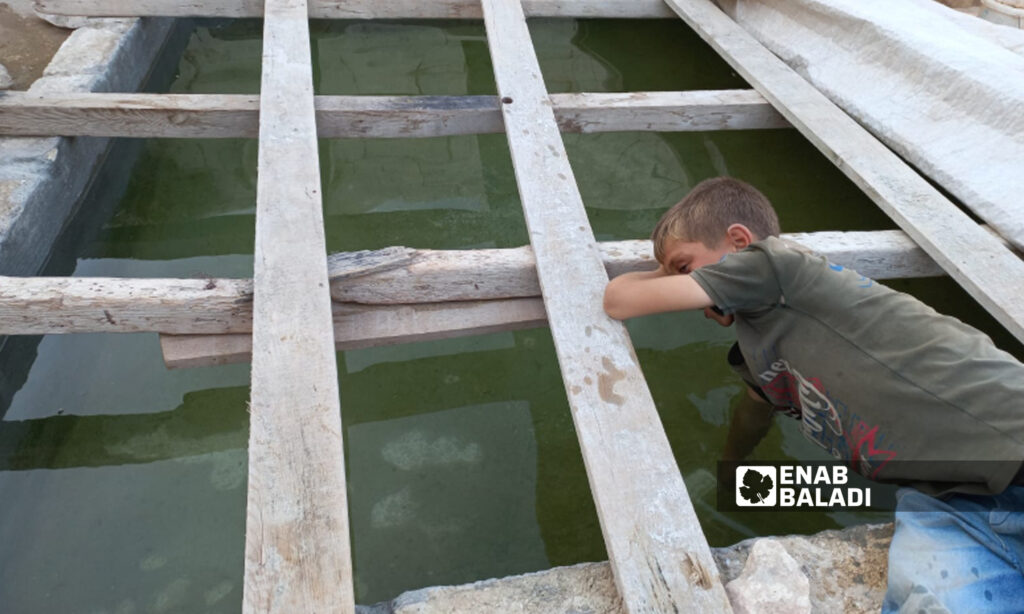Enab Baladi – Idlib
Child deaths and injuries, whether by drowning or falling into water wells or while working in them, are frequent within the northern Syrian regions at the beginning of the summer.
The five-year-old Youssef Duqmaq was one of the six victims of children who died in the same way in the Idlib and Hama countryside as attempts by the Syria Civil Defense (SCD) team to rescue him were unsuccessful.
On 15 May, Youssef, of the town of Iblin, south of Idlib governorate, was found drowning in a pond of water intended for cultivation, about an hour after he was lost after all attempts to rescue him had failed.
With the advent of summer each year, Idlib governorate records dozens of deaths of men and children in various drowning accidents due to the dangerousness of water ponds in the area and their unsuitability for swimming.
Nuha al-Hallaq, 38, a resident in Iblin, told Enab Baladi that the pool of water in which Youssef fell had no roof or fence, and at a depth of more than two meters, which made the possibility of falling inside it great, and the chances of surviving from it were slim for a 5-year-old child.
One week before this incident, a group of farmers managed to save another nine-year-old child while he was swimming in the same pond, which shows the danger of these water bodies to children and the need to take measures of prevention and safety by fencing them and making them safe.
From the beginning of 2022 until 3 June, the SCD teams responded to 14 distress calls for drowning cases in northwestern Syria, during which they managed to rescue six people who fell in water wells, while the bodies of ten others were recovered, according to the statistics of the official website of the rescue team.
During the past year, the Civil Defense targeted 45 volunteers from its teams in all regions of northwestern Syria with diving and rescue training, which were divided into three levels.
They were also selected by a panel of specialized diving instructors and subjected to fitness and swimming tests, as well as general medical tests.
More painful stories
In a similar incident, the 3-year-old Saleh al-Jinki and his 5-year-old sister Yaman died while they were swimming in an irrigation pool in the town of Binnish in the eastern countryside of Idlib.
Mohammad al-Khaled, 35, who was a witness to the incident, told Enab Baladi that the displaced children were playing near the water pond while their father was busy working on his agricultural land when he was surprised that they disappeared from his sight to find that they had drowned.”
The witness added that Yaman “was taking her last breath when her father pulled her out of the pond, while Saleh was dead. All attempts by the emergency teams to save Yaman failed because a large amount of water leaked into her lungs, which led to her death shortly after.
Earlier, the SCD warned the people, especially after the temperatures began to rise, not to approach the banks of rivers, water ponds, and wells.
The volunteer group called on parents and farmers to report any exposed wells or digging within their areas to secure them to protect the people and their children.
Living conditions one of the reasons
For entertainment, people flock to the water ponds for swimming in the summer, or farmers rely on the ponds to water their crops, especially in the southern countryside of Idlib and the al-Ghab Plain, which contributes to an increase in drowning incidents.
Raed Salloum, a volunteer in the SCD, told Enab Baladi that the economic and living conditions impose themselves every time on the people and residents in Idlib “to form many dangerous phenomena, most notably the many drowning incidents that claimed the lives of dozens of people, most of them children.”
The rise in swimming pools and parks’ fees prompted most of the local residents to spend time on the banks of rivers and ponds, which are highly dangerous as a result of strong currents and varying levels of depth in these ponds as well as the large number of rocks and hard weeds that impede the person’s movement and make him lose control over water, which leads to drowning, Salloum says.
He added that this prompted most of the area’s residents to get used to children swimming in agricultural ponds, but the roofing of these ponds must be done to prevent the recurrence of drowning incidents.
Despite the roving awareness campaigns and informational brochures distributed by the Civil Defense, some people do not care about the instructions because there are no laws that deter swimming in dangerous lakes and rivers.
The most prominent areas witnessing cases of drowning are the banks of the Orontes River and the Euphrates River, Lake Medanki, and Ain al-Zarqa.
The Civil Defense team also recorded cases in the riverbeds scattered in northwestern Syria, as well as industrial ponds designated for agriculture, which caused cases of drowning, including children.
In 2020, the Civil Defense documented that more than 45 people drowned in northwestern Syria, and in the years 2018 and 2019, diving teams rescued 95 civilians, including 23 children and 12 women.











